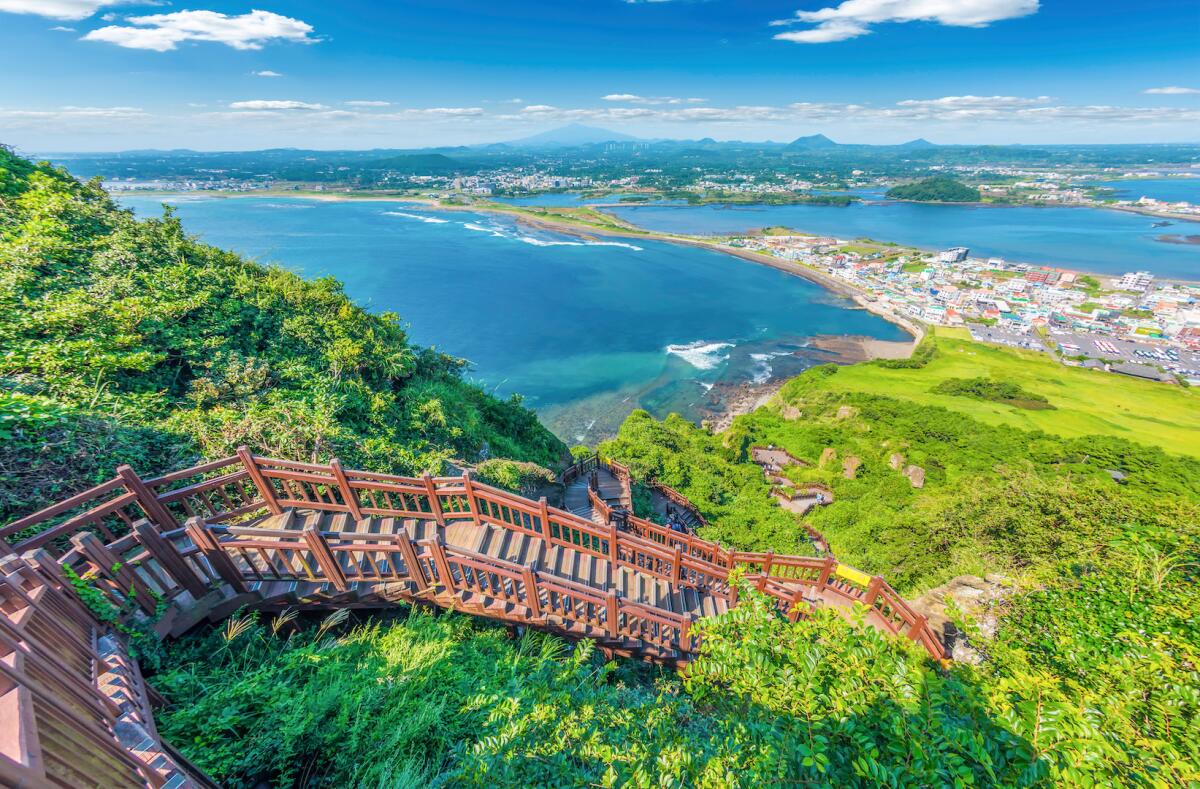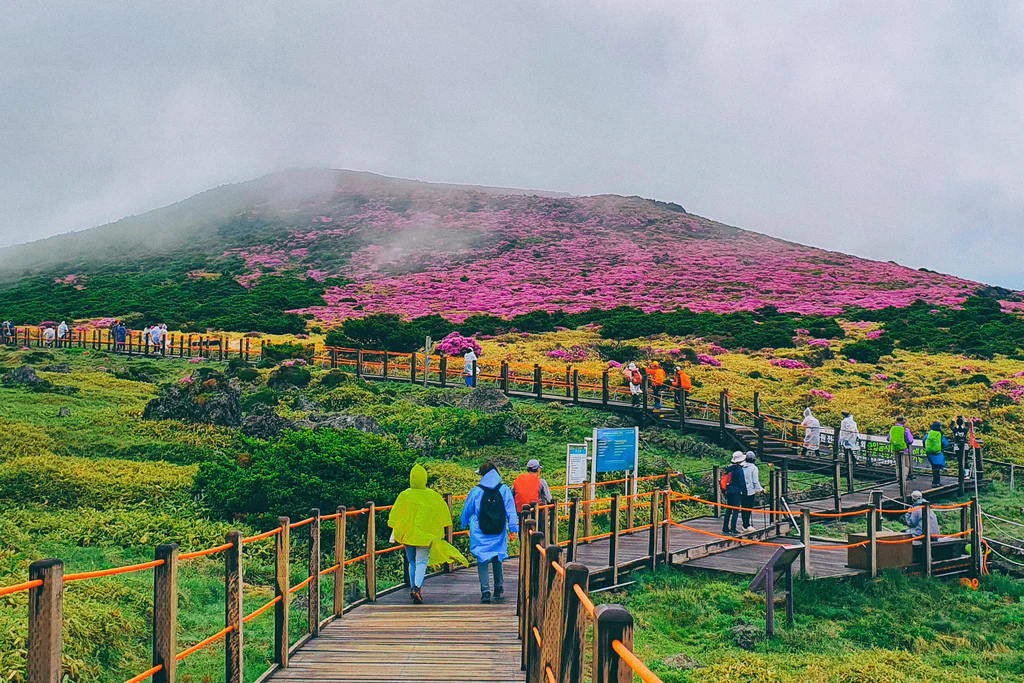🌊 Jeju Island, South Korea
Jeju Island (제주도) is a stunning volcanic island located off the southern coast of South Korea. Known for its natural beauty, unique culture, and UNESCO World Heritage sites, Jeju is a popular destination for both locals and international travelers. It offers breathtaking landscapes, from dramatic waterfalls and lava tubes to pristine beaches and the majestic Hallasan Mountain.
📅 Best Time to Visit:
- Spring (April - June): Ideal for mild weather and blooming flowers, including the famous canola fields.
- Summer (July - August): Perfect for beach activities, but expect humid weather and occasional typhoons.
- Autumn (September - November): Pleasant weather and colorful foliage make this a great time for hiking.
- Winter (December - February): Mild winters with occasional snow on Hallasan Mountain for scenic winter hikes.
✈️ How to Get There:
- By Air:
- Direct flights from Seoul (Gimpo), Busan, Daegu, and other major South Korean cities.
- International flights from Tokyo, Shanghai, Hong Kong, and more.
- Airports: Jeju International Airport (CJU) – located near Jeju City.
- By Ferry:
- Ferries operate from mainland cities like Busan and Mokpo to Jeju. Ideal if you want to bring a car.
🌟 Top Attractions:
-
Hallasan Mountain (한라산)
- South Korea’s highest peak (1,947m) and a dormant volcano.
- Popular for hiking, with trails like Seongpanak and Gwaneumsa offering stunning views.
- UNESCO-listed and beautiful in all seasons, especially in autumn.
-
Seongsan Ilchulbong (성산 일출봉)
- Also known as Sunrise Peak, a volcanic crater famous for breathtaking sunrise views.
- UNESCO World Heritage site. Moderate 20-30 minute hike to the summit.
-
Manjanggul Cave (만장굴)
- One of the longest lava tubes in the world (7.4 km).
- A UNESCO-listed site with impressive stalactites, lava columns, and cool underground air.
-
Jeongbang Waterfall (정방폭포)
- The only waterfall in Asia that falls directly into the sea.
- Located near Seogwipo City—an easy and beautiful coastal walk.
-
Cheonjiyeon & Cheonjeyeon Waterfalls (천지연 폭포)
- Cheonjiyeon is known as "the pond of heaven," surrounded by lush greenery.
- Cheonjeyeon is a three-tiered waterfall linked to local myths about fairies.
-
Udo Island (우도)
- A small island off Jeju’s east coast known for white sand beaches, sea caves, and local seafood.
- Accessible via a 15-minute ferry ride from Seongsan Port.
-
Hamdeok Beach (함덕 해수욕장)
- A popular beach with crystal-clear turquoise waters and soft white sand.
- Ideal for swimming, snorkeling, and beach picnics.
-
O’Sulloc Tea Museum
- Explore Korea’s tea culture and sample green tea grown on Jeju’s volcanic soil.
- Beautiful tea fields and a serene atmosphere.
🎟️ Unique Experiences:
- Visit a Haenyeo Village:
- Watch the haenyeo (female divers) harvest seafood using traditional free-diving techniques.
- Jeju Folk Village:
- Experience traditional Jeju life with preserved homes and cultural exhibits.
- Loveland:
- An adult-themed sculpture park known for playful and artistic depictions of love.
🍽️ Local Cuisine to Try:
- Jeju Black Pork (흑돼지):
- Famous for its rich flavor and best enjoyed as Korean BBQ.
- Haemul Jeongol (Seafood Hot Pot):
- Fresh seafood stew with abalone, squid, and shellfish.
- Jeonbokjuk (Abalone Porridge):
- A nourishing local delicacy made with Jeju’s fresh abalone.
- Hallabong Oranges:
- Sweet, seedless mandarins unique to Jeju. Available fresh or as juice.
- Dombe Meat (돔베고기):
- Sliced boiled pork, served with kimchi and soy dipping sauce.
🏨 Accommodation Options:
- Luxury:
- Grand Hyatt Jeju: Modern luxury in Jeju City, with spa and panoramic views.
- The Shilla Jeju: A 5-star resort near Jungmun Beach offering world-class amenities.
- Mid-Range:
- Maison Glad Jeju: Stylish rooms near Jeju City and the airport.
- Shin Shin Hotel Jeju: Comfortable and affordable, ideal for city exploration.
- Budget:
- Yeha Guesthouse: Popular with backpackers, includes airport shuttle service.
- Jeju Olle Guesthouse: Cozy stay near hiking trails and beaches.
🎎 Local Culture of Jeju Island
Jeju Island’s culture is distinct from mainland South Korea, shaped by its volcanic landscape, matriarchal traditions, and deep-rooted folklore. The island’s isolation has preserved unique customs, dialects, and spiritual practices that reflect the resilience and creativity of its people.
🌊 1. Haenyeo Culture (Women Divers)
- Who are the Haenyeo?
- Jeju’s iconic haenyeo are female divers who harvest seafood (abalone, seaweed, clams) by free-diving without modern equipment.
- This tradition dates back over 1,000 years and represents female empowerment and economic independence.
- In 2016, UNESCO recognized haenyeo culture as Intangible Cultural Heritage.
- Experience It:
- Visit a haenyeo village (like Seongsan or Hado) to watch diving demonstrations.
- Explore the Haenyeo Museum to learn about their history and daily lives.
🗣️ 2. Jeju Dialect (Jeju-eo)
- Jeju locals speak a unique Jeju dialect (제주어), which is almost incomprehensible to standard Korean speakers.
- It reflects the island’s history and incorporates words from Mongolian and Japanese influences.
- Common Phrases:
- "Hallasan-e gamyeon dwa" (한라산에 가면 돼) – “Go to Hallasan!”
- "Mul meogeo" (물 먹어) – “Drink water.”
🌄 3. Shamanism & Folk Beliefs
- Shamanism is deeply embedded in Jeju’s cultural identity, with over 18,000 gods and spirits believed to protect the island.
- Grandmother Seolmundae (설문대 할망): A mythical giant who, according to legend, created Hallasan Mountain.
- Dol Hareubang (돌 하르방):
- Stone statues resembling old men that guard villages and are believed to ward off evil spirits.
- You’ll find them at temple entrances and tourist sites.
🎤 4. Festivals & Celebrations
- Jeju Fire Festival (정월대보름 들불축제) (March): Celebrates new beginnings by burning fields to ensure a good harvest.
- Chilseong Festival (칠성제) (August): Honors shamanic gods with rituals and performances.
- Mandarin Harvest Festival (November-December): Celebrates Jeju’s famous hallabong tangerines.
🏠 5. Jeju’s Traditional Homes (Choga-jip)
- Made from volcanic stone and thatched roofs, these homes are built to withstand strong winds and typhoons.
- Fences made of stacked black basalt (Doldam) symbolize protection and privacy.
- Visit the Jeju Folk Village for a living history experience of these ancient houses.
🧧 6. Community & Social Structure
- Historically, Jeju followed a matriarchal society, led by women like the haenyeo.
- Jeju people emphasize community cooperation, especially in agriculture and fishing.
- Jeong (정): The concept of empathy and connection is deeply valued, and visitors are often welcomed with kindness.
📜 7. Myths & Legends
- The Legend of Seolmundae Halmang:
- A giant goddess who created Jeju Island by pouring soil from her skirt.
- Dragon King’s Palace:
- Local lore claims that Yongduam Rock (Dragon Head Rock) was once a dragon turned to stone.
- Seven Fairies of Cheonjeyeon:
- It is believed that seven nymphs descend from heaven to bathe in the Cheonjeyeon wat



